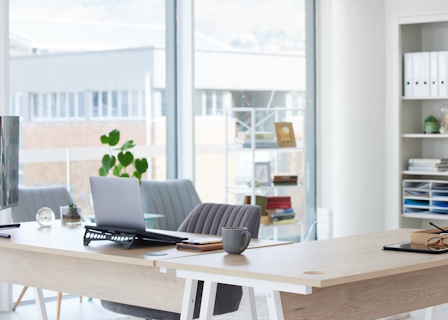A Practical Guide to Choosing the Right Office Desk for Comfort and Productivity

Choosing the right office desk means finding the right style and the right size for your needs. The size and dimensions of a desk can significantly impact comfort, productivity, and how effectively a workspace functions. Whether furnishing a home office, a corporate setting, or a shared workspace, understanding desk measurements and standard sizes ensures that the setup supports both work habits and ergonomics.
This guide breaks down key considerations, explains standard desk sizes, and provides useful office desk ideas to help anyone make informed decisions when planning a workspace.
Understanding the Importance of Desk Size
An office desk that is too small can feel cramped and cluttered, while one that is too large may overwhelm a room or make the space feel awkward. The right desk should provide enough surface area to accommodate essential items such as a computer, monitors, and organizational tools while leaving room for comfortable movement.
Ergonomics also plays a role. The height and width of a desk affect posture, reach, and overall comfort. When a desk fits well with the user’s body and workspace, it reduces strain on the back, shoulders, and arms, leading to better focus and efficiency throughout the day.
Standard Desk Size: What to Expect
Most office desks follow common dimensions that are designed to suit a variety of users and work environments. A typical standard desk size is about 60 inches wide, 30 inches deep, and 30 inches high. This provides ample workspace for a computer or laptop, writing materials, and other office essentials.
For smaller areas, compact desks often range from 42 to 48 inches in width while maintaining the standard height of 30 inches. These are ideal for home offices or shared spaces where maximizing floor space is a priority. Conversely, executive desks or larger workstations can exceed 72 inches in width and include additional storage or workspace areas.
Depth is another important factor. A desk that is too shallow may leave limited room for monitors, keyboards, and other work materials. A depth of 30 inches is standard for most desks, providing enough space for computer screens and a comfortable distance for typing. Larger depths of 36 inches or more are useful for multi-monitor setups, creative work, or layouts that require extra surface area.
Desk Height and Ergonomics
Desk height affects posture and comfort. The standard height of 29 to 30 inches is suitable for most adults when paired with an adjustable chair. For tasks that involve drawing, drafting, or other detailed work, slightly higher desks may be preferable. Adjustable-height office desks or sit-stand options are increasingly popular, allowing users to switch positions throughout the day to reduce fatigue.
Keyboard and monitor placement are also influenced by desk height. A comfortable height ensures that arms rest at roughly a 90-degree angle while typing and that the top of the monitor aligns with eye level. Proper alignment prevents strain on the neck, shoulders, and wrists, making desk dimensions a crucial component of ergonomic design.
Desks in Office Layouts
Considering the desk’s dimensions in the context of the overall office layout is essential. An office desk should fit comfortably within the space without obstructing walkways or crowding other furniture. Measuring the available area and leaving room for chairs, filing cabinets, and movement ensures a functional workspace.
For open-plan offices or shared workspaces, modular desks or L-shaped desks provide flexibility while maintaining efficient use of space. These designs often incorporate additional surface area or storage while minimizing disruption to the room’s flow. In-home offices, corner desks, or compact designs maximize space without sacrificing functionality.
Office Desk Ideas for Every Space
When planning for your new office desk, it’s helpful to consider a variety of office desk ideas to suit different needs and aesthetics:
- Minimalist Desks: Clean lines and simple surfaces work well in smaller rooms or for those who prefer uncluttered spaces.
- L-Shaped Desks: Ideal for corner placement, providing ample surface area while keeping equipment and documents within easy reach.
- Adjustable or Sit-Stand Desks: These desks allow users to alternate between sitting and standing, promoting movement and reducing strain.
- Executive Desks: Larger desks with integrated storage and additional surface space suit high-traffic work areas or home offices that double as professional spaces.
- Floating or Wall-Mounted Desks: For tight spaces, these designs can save floor space while still offering a functional workspace.
Incorporating storage solutions, such as drawers, shelves, or filing cabinets, complements desk dimensions and enhances organization. Balancing surface space with storage ensures the office desk remains functional without becoming overcrowded.
Tips for Choosing the Right Desk Size
Several practical tips can help anyone select the right office desk dimensions:
- Measure Your Space: Know the length, width, and height of the area where the desk will go, and leave room for movement and other furniture.
- Consider Your Tasks: Identify what the desk will be used for — computers, paperwork, creative projects — and ensure the surface area can accommodate these activities.
- Prioritize Ergonomics: Desk height, chair compatibility, and monitor placement are key to comfort and productivity.
- Plan for Storage Needs: Decide whether drawers, shelving, or filing cabinets are necessary to keep the workspace organized.
- Test Before Buying: Whenever possible, try out the desk to ensure comfort and functionality in real-world conditions.
Making the Most of Your Office Desk
The right desk size and design contribute to a more comfortable, efficient, and attractive workspace. Understanding standard desk sizes, the relationship between height and ergonomics, and the layout of the desk in the office ensures that it not only fits the room but also supports the work being done.
By evaluating office desk dimensions, considering layout and storage needs, and exploring creative desk ideas, anyone can create a space that encourages focus and productivity. A thoughtfully chosen desk becomes more than just a piece of furniture; it’s the foundation of a well-designed workspace.
